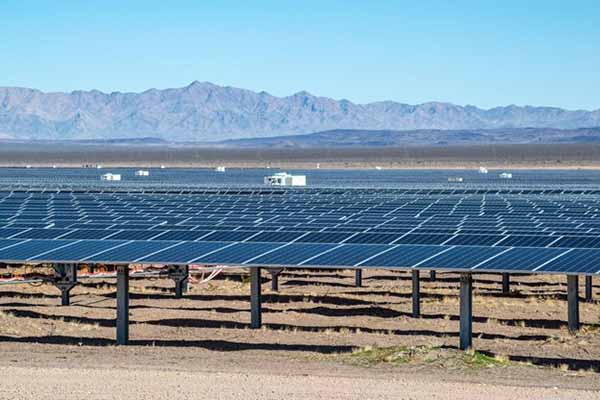Renewable energy sources produced more electricity than nuclear power in the United States last year for the first time ever.
Wind, hydropower, and utility-scale solar power generated 20% of the nation’s electricity in 2021, or 795 million megawatt-hours (MWh). Nuclear power produced 778 million MWh, around 19% of the grid’s electricity, and its lowest level since 2012.
Despite several coal-fired power stations retiring in 2021, the coal sector of the fossil fuel industry saw a rise in its electricity generation for the first time since 2014. That meant coal produced more power than renewables last year, some 22% of the total.
Natural gas remained the largest electricity generation source in the U.S. at 1,474 million MWh (38%).
Wind and Solar Push Renewable Power Forward
The renewable figures include electricity generated from wind, solar, hydropower, geothermal, and biomass sources. It doesn’t include small-scale solar or wind installations in residential, commercial, or industrial sectors.
According to the U.S. Energy Information Administration (EIA), the increase in renewable power generation in 2021 was thanks to wind turbines and utility-scale solar power plants coming online.
Utility-scale solar generation grew considerably, by 28%, accounting for 2.8% of the nation’s electricity production. Wind generation jumped by 12% to make up 9.2% of U.S. electricity production.
Hydropower contributions dropped to their lowest level since 2015 because of dry weather in western states. Still, they accounted for 6.3% of the nation’s electricity generation.
Biomass (1.3% of national electricity production) and geothermal (0.4%) remained almost unchanged in 2021.
More Renewables Forecast for the Future
The EIA foresees renewable electricity generation increases in the next few years as more solar and wind projects come online.
Renewables’ 20% share of electricity production in 2021 is predicted to increase to 22% this year and 23% in 2023. Around half of the new renewable production additions will be solar, with significant utility-scale and small-scale capacity being added.
Natural gas is predicted to slowly lose market share, staying at the 2021 level 37% in 2022 and then dropping to 35% in 2023. Coal will be hit too, from its 23% share in 2021 to 20% in 2023. Nuclear’s part of the power mix is anticipated to remain the same.
Renewables a Long Way From Net-Zero Roadmap
President Joe Biden has pledged to make the United States federal government’s procurement net-zero for emissions by 2050 to try to keep global temperature increases below 1.5 degrees Celsius (2.7 degrees Fahrenheit).
The International Energy Agency’s global net-zero scenario requires 90% of electricity to come from renewables by 2050. Around 70% of that worldwide electricity should come from solar and wind, putting the U.S. behind the curve.
Renewable electricity generation needs to marry with technological shifts away from fossil fuels too, to achieve this goal. Requirements include the mass adaptation of electric cars and trucks, energy efficiency, heat pumps to warm buildings, and electric furnaces for industry.
Is Renewable Energy the Backbone of Energy Independence?
Global events have highlighted how dependent many countries are on fossil fuel supply chains. Renewable energy is a much more localized energy source. Despite the United States’ improvements in clean energy, the government has found its energy independence under stress.
The Ukraine conflict has led to the U.S. and many countries banning fuel imports from Russia.
Last year, Russia accounted for around 25% of the United States’ crude oil imports. Still, businesses are now sourcing alternative supplies from the Middle East and Latin America.
Batteries Vital to Renewable Energy Boom
Fossil fuels like gas and coal can be stored for future use. In contrast, renewable energy needs to be used immediately or lost. Utility-scale battery storage plants can store excess energy generated by renewable energy for later use.
In 2019, the U.S. had approximately 1,688 megawatt-hours (MWh) of large-scale battery storage capacity, tiny compared to renewable’s nationwide generation of 795 million megawatt-hours (MWh) last year. The country will add around 10,000 megawatts of extra battery storage capacity between 2021 and 2023. It’s hoped that falling battery installation costs will boost both utility-scale and small-scale battery storage schemes.
While renewables’ improved performance is to be welcomed, the nation’s complex energy picture, dependence on fossil fuels, and lack of utility-scale battery storage highlight the challenges facing policymakers on the road to 2050’s net-zero emissions target.
Opinion writer: Tom Shearman
The opinions, beliefs, and viewpoints expressed by the various authors do not necessarily reflect the opinions, beliefs, or viewpoints of Interactive Energy Group, LLC (IEG) or its parent companies or affiliates and may have been created by a third party contracted by IEG. Any content provided by the bloggers or authors are of their opinion and are not intended to malign any individual, organization, company, group, or anyone or anything.
Brought to you by energysavings.com
All images licensed from Adobe Stock.
Featured Image

